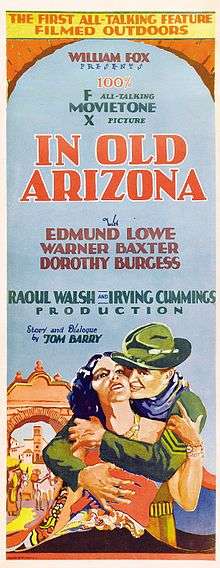In Old Arizona
| In Old Arizona | |
|---|---|
 Theatrical release poster | |
| Directed by | Irving Cummings |
| Produced by | Winfield Sheehan |
| Written by | Tom Barry |
| Starring |
Warner Baxter Edmund Lowe Dorothy Burgess |
| Cinematography |
Arthur Edeson Alfred Hansen |
| Edited by | Louis R. Loeffler |
| Distributed by | Fox Film Corporation |
Release date |
Premiere: December 25, 1928 General release: January 20, 1929 |
Running time | 95 minutes |
| Country | United States |
| Language | English |
| Box office | $1.3 million[1] |
In Old Arizona is a 1928 American Pre-Code Western film directed by Irving Cummings, nominated for five Academy Awards, including Best Picture. The film, which was based on the character of the Cisco Kid in the story "The Caballero's Way" by O. Henry, was a major innovation in Hollywood. It was the first major Western to use the new technology of sound and the first talkie to be filmed outdoors. It made extensive use of authentic locations, filming in Bryce Canyon National Park and Zion National Park in Utah, and the Mission San Juan Capistrano and the Mojave Desert in California. The film premiered in Los Angeles on December 25, 1928 and went into general release on either December 28, 1928 or January 20, 1929.
In Old Arizona contributed to creating the image of the singing cowboy, as its star, Warner Baxter, does some incidental singing. Baxter went on to win the Academy Award for Best Actor for his performance. Other nominations included Best Director for Irving Cummings, Best Writing for Tom Barry, Best Cinematography for Arthur Edeson, and Best Picture.
Plot synopsis
In Arizona, a bandit known as The Cisco Kid robs a stagecoach. Word of this deed reaches to Sergeant Micky Dunn, who gets tasked by his superior to bring in The Cisco Kid dead or alive, with a $5,000 reward promised once he succeeds. They meet in a barber shop, though Dunn is unaware of The Cisco Kid's true identity and passes him off as a friendly civilian. When he leaves, the local blacksmith tells him that was The Cisco Kid, much to Dunn's chagrin.
The Cisco Kid is in a relationship with Tonia Maria, and visits her often. He loves her, but she has frequent affairs without his knowledge. Dunn and Maria meet each other and begin an affair. Dunn tells Maria that once he takes down The Cisco Kid, he will give the $5,000 reward to Maria, making her fall in love with him. They express their love for each other while The Cisco Kid secretly watches and listens nearby, learning of her betrayal.
She writes a secret letter to Dunn telling him to come that evening to take down The Cisco Kid before he makes his escape. However, The Cisco Kid finds this letter and replaces it with a fake letter "from Maria" which he wrote. His note says that he will be dressed up in Maria's clothes in an effort to disguise himself from Dunn, while Maria is actually in The Cisco Kid's clothes riding away. Dunn receives this fake letter, believing it to be from Maria. When The Cisco Kid leaves her house, Dunn shoots Maria, believing her to be The Cisco Kid in disguise. Now farther away, The Cisco Kid laments that "[Maria's] flirting days are over, and she can finally settle down". He then makes his escape.
Cast
- Warner Baxter as The Cisco Kid
- Edmund Lowe as Sergeant Mickey Dunn
- Dorothy Burgess as Tonia Maria
Production
Raoul Walsh was set to direct and star as the Cisco Kid in this film, but had to abandon the project when a jackrabbit jumped through a windshield of a vehicle he was driving and cost Walsh an eye, after which he wore an eyepatch for the remainder of his life. Walsh never acted again but continued his illustrious career as a film director.
Preservation
The Academy Film Archive preserved In Old Arizona in 2004.[2]
See also
References
- ↑ Quigley Publishing Company "The All Time Best Sellers", International Motion Picture Almanac 1937-38 (1938), page 942; accessed April 19, 2014.
- ↑ "Preserved Projects". Academy Film Archive.
External links
- In Old Arizona at the American Film Institute Catalog
- In Old Arizona on IMDb
- In Old Arizona at AllMovie
- In Old Arizona at the TCM Movie Database
- "In Old Arizona" on YouTube